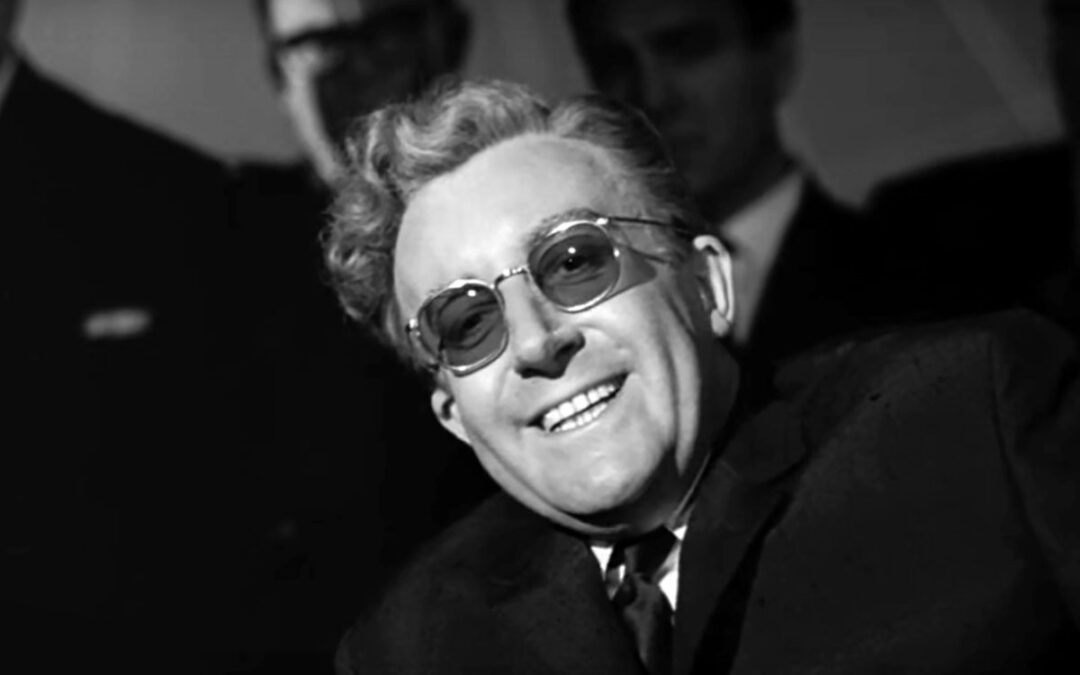“Dr. Strangelove or: How I Learned to Worrying And Love the Bomb” is Stanley Kubrick’s best film – and to this day remains the boldest and funniest movie ever made. In 1964 – at the height of the Cold War and when the Cuban Missile crisis was fresh on everyone’s minds – Kubrick had the chutzpah to make a movie about what would happen if the go ahead for total nuclear annihilation is made by an unhinged United States Air Force General – and do it for laughs. What ensues is a pitch black satire – one that hasn’t lost is edge – or its freshness.
There are so many delights in this film – starting with Peter Sellers – playing brilliantly – not one but three different characters. This is a true tour de force. The directing is done with a light touch but with scalpel precision and timing. The production design is extraordinary – the set for the war room sequences is one of the most spectacular and iconic in movie history.
Kubrick turned to humor because he understood there was absurdity in the escalation of war and in the abuse of power. He said, “My idea of doing it as a nightmare comedy came in the early weeks of working on the screenplay. I found that in trying to put meat on the bones and to imagine the scenes fully, one had to keep leaving out of it things which were either absurd or paradoxical, in order to keep it from being funny; and these things seemed to be close to the heart of the scenes in question.” The film satirizes numerous contemporary war attitudes – machismo – and its full of sexual imagery – sometimes subtle – sometimes very direct.
I think we all need a good laugh – when facing absurd situations – the best medicine is just a good laugh.
Love,
Roger
(Available to stream on Crackle. Available to rent on iTunes, Vudu, Amazon Prime, YouTube and Google Play.)
Written by Stanley Kubrick, Terry Southern and Peter George
Directed by Stanley Kubrick
Starring: Peter Sellers, George C. Scott, Sterling Hayden, Keenan Wynn, Slim Pickens and Tracy Reed
95 minutes
A film about what could happen if the wrong person pushed the wrong button — and it played the situation for laughs. U.S. Air Force General Jack Ripper goes completely insane, and sends his bomber wing to destroy the U.S.S.R. He thinks that the communists are conspiring to pollute the “precious bodily fluids” of the American people.
About Writer and Director Stanley Kubrick
Stanley Kubrick was born on July 26, 1928, in the Bronx. As a child he was encouraged by his father, a doctor, to take up still photography, and when he was 17 he was hired as a staff photographer by Look magazine. In 1950 he quit his job at Look to make his first film, Day of the Fight, a 16-minute documentary, which he sold to RKO-Pathe. He completed two more documentary shorts before making his feature debut in 1953 with Fear and Desire. After making a second feature, Killer’s Kiss, he formed a production company in 1954 with a producer, James B. Harris. Mr. Kubrick’s fourth full-length film, Paths of Glory, established him as one of the most promising postwar American filmmakers. Two years later, in 1959, Mr. Kubrick was invited to replace Anthony Mann, the director of the high-budget Roman epic Spartacus. The successes of Spartacus, Lolita and Dr. Strangelove gave Mr. Kubrick the rare freedom to choose his subjects and to control his projects. For the next several years, he worked on the science fiction epic 2001, which he wrote with Arthur C. Clarke. His other films include A Clockwork Orange, Barry Lyndon, The Shining, Full Metal Jacket, and Eyes Wide Shut. (New York Times)
Choosing Dr. Strangelove
Kubrick was deeply troubled by the prospect of nuclear war…it was the only thing on his mind after finishing “Lolita.” This led him to read more than 50 books on the subject, one of which came recommended from a friend at the International Institute for Strategic Services: Peter George’s novel “Red Alert.” Kubrick paid $3,500 for the rights to the novel, eventually writing an adaptation called “The Edge of Doom.” (IndieWire) “As Kubrick worked on the script, however, he kept bumping up against the realization that the scenes he was writing were funny in the darkest possible way. It was a matter of slipping on a banana peel and annihilating the human race.” (Rolling Stone)
The Making of Dr. Strangelove
“Kubrick was known to be a stationery fanatic, as well as compulsive note-taker, and often used index cards…as a preferred method of annotation and documentation in the development of his films. Despite his meticulous research, US government security meant that certain information was impossible for Kubrick to obtain. The US Air force denied Kubrick access to its B-52s during his research for the building of the bomber ‘Leper Colony’, leaving production designer Ken Adam to search technical magazines in order to get the information needed to replicate the planes.” (BFI)

